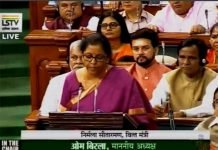The finance minister of India, Nirmala Sitharaman, presented the Union Budget 2019-2020 in Parliament on 5 July 2019. She chose a red bag to carry a budget report instead of the usual brown briefcase. The budget reflected the government’s vision of growing the Indian economy to reach a GDP of US$ 5 trillion by 2025. It emphasized food related sectors such as agriculture, dairy and fisheries.
Sitharaman stressed both self-sufficiency and export of food grains. She mentioned that “Annadata can also be Urjadata” and assured the government’s committment to invest widely in agriculture infrastructure before announcing that over the next five years, 10,000 new Farmer Producer Organizations (FPO) will be formed.
She spoke about the promotion of the milk and dairy industry through cooperatives by creating infrastructure for cattle feed manufacturing, milk procurement, processing and marketing. She also addressed the need for a robust fisheries management framework and announced that a framework under Pradhan Mantri Matsya Sampada Yojana (PMMSY) by the Department of Fisheries would be established. This framework will address critical gaps in the value chain, such as traceability, production, post-harvest management and quality control.
Other highlights of the budget included steps to increase investments in MSMEs, start-ups, Make in India and electric mobility; measures to simplify tax compliance; announcements for women of the country; special emphasis on strengthening the start-up ecosystem in India; ease of local sourcing norms for FDI in single brand retail; and an increase in fuel prices.
Sandeep Sabharwal, chief executive officer, SLCM Group said that the finance minister has underscored the role of cooperatives and FPOs in ensuring better prices of crops. He said, “The government’s decision to form 10,000 new farmer producer organizations will help in ensuring economies of scale for farmers. The promise to set up livelihood business incubators and technology business incubators for producing skilled entrepreneurs in agro-rural industries will give a boost to the rural entrepreneurship.”
Sabharwal praised the government’s decision on Zero Budget Farming, which will help make farmers self-reliant. He added, “The decision to provide one woman in every self-help group, a loan of up to Rs 1 lac under the Mudra Yojana Scheme will encourage more and more women to come forward and participate in the economic process in rural India. The decision to increase the expenditure in rural infrastructure development under PMGSY is another positive move which will help in boosting the rural economy. For industry, the decision to bring down the corporate tax for companies with an annual turnover of up to Rs 400 crore to 25% from 30% earlier will help them in a big way.”










